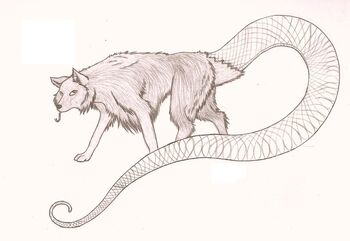No edit summary |
No edit summary |
||
| Line 3: | Line 3: | ||
==Description== |
==Description== |
||
It has a short head, large fangs and its external ears are lacking or rudimentary; short and flat feet (plantigrade) with three fingers on its front paws and four on the rear ones, joined by a natatory membrane and with formidable claws. The tail is long, depressed and prehensile. The body is covered with short, hard and rigid hairs, of a uniform brownish color. The size is said to be larger than that of a puma, but with shorter legs and a much thicker body. |
It has a short head, large fangs and its external ears are lacking or rudimentary; short and flat feet (plantigrade) with three fingers on its front paws and four on the rear ones, joined by a natatory membrane and with formidable claws. The tail is long, depressed and prehensile. The body is covered with short, hard and rigid hairs, of a uniform brownish color. The size is said to be larger than that of a puma, but with shorter legs and a much thicker body. |
||
| + | |||
| + | It uses its powerful tail to crush its enemies and then drags them to its lair to be devoured |
||
It said that its body cannot be penetrated by missiles or burning branches. |
It said that its body cannot be penetrated by missiles or burning branches. |
||
Revision as of 12:40, 6 January 2014

Artist rendering
Iemisch, Yemisch or water tiger is mythical creature from Tehuelche people of Patagonia, South America. It said to resemble a fox in the upper-part, adn lower part of serpent. It was first mentioned in Ameghino’s 1898 mylodon paper. Ameghino contended that his Neomylodon and Iemsich were the same creature. Could he have been correct in his assumption?
Description
It has a short head, large fangs and its external ears are lacking or rudimentary; short and flat feet (plantigrade) with three fingers on its front paws and four on the rear ones, joined by a natatory membrane and with formidable claws. The tail is long, depressed and prehensile. The body is covered with short, hard and rigid hairs, of a uniform brownish color. The size is said to be larger than that of a puma, but with shorter legs and a much thicker body.
It uses its powerful tail to crush its enemies and then drags them to its lair to be devoured
It said that its body cannot be penetrated by missiles or burning branches.
History
Surprisingly, before Ameghino, not one single Patagonian explorer had ever mentioned the Iemisch; and there are no other records of any Aonikenk myths referring to an animal named Iemisch.
To be fair, there are references to Aonikenk monsters such as Goshg-e, which though not described as aquatic, was very similar to the Iemisch in its dreadful size and aggressiveness.
For this reason, Ameghino’s Iemisch was quickly under attack by other scientists, so he was forced to defended himself. In a letter dated April 4th, 1901 to German-Brazilian Dr. Herman von Ihering he said that “the references to Jemisch [sic] are exploited in ill faith. I have not described the Neomylodon by references but from the mentioned bones […] and simply referred the descriptions of a large mammal that inhabits the Patagonian lakes […] if these descriptions are not reliable, the blame is not mine […] Probably there is not only one mysterious mammal living in Patagonia, but several”.
In his letter he enclosed a clipping of the Buenos Aires daily La Nación, in which his witnesses were not voluble natives, but supposedly more reliable “white people”. Regarding the article, Ameghino noted that “Steinkanpen was accompanied by two cow hands by the name Montesinos who live in Chubut and two sons, one aged 18, the other 16. The five of them saw the monster. Mr. Zubizarreta was accompanied by several soldiers. I have spoken to others who have shot at Jemish [sic] from a distance of 3 meters [9 ft.]”.
Shortly before, on March 3rd, 1901, his brother had written to him cheerfully “it seems that the mylodon has been seen this time in the mountains by the Gallegos River by neighbors of that place, and it is not improbable that any moment we may get the news that it has been hunted. This time it seems to me that it is true and serious”.
De Basaldúa was also on the look out, and in July 1901 wrote to Florencio that he was corroborating “very important news on the Neomylodon Listai”.
What came of these leads no one knows. There is no further correspondence on the matter, Neomylodon and Iemisch vanished.
French naturalist André Tournouer saw a creature emerge in the middle of a stream, during his 1900 Patagonian expedition, it has round head that was the size of a large puma, with dark fur. Its eyes were encircled with light yellow hair. It lacked external ears.
He shot at it and the animal quickly disappeared under the water. He later came across some large cat-like tracks in the sand.
His native guide seemed very frightened and told him that beast and tracks belonged to the mysterious Hymché.
Tournouer was certain that it was not a Neomylodon and believed that it was a carnivore.
